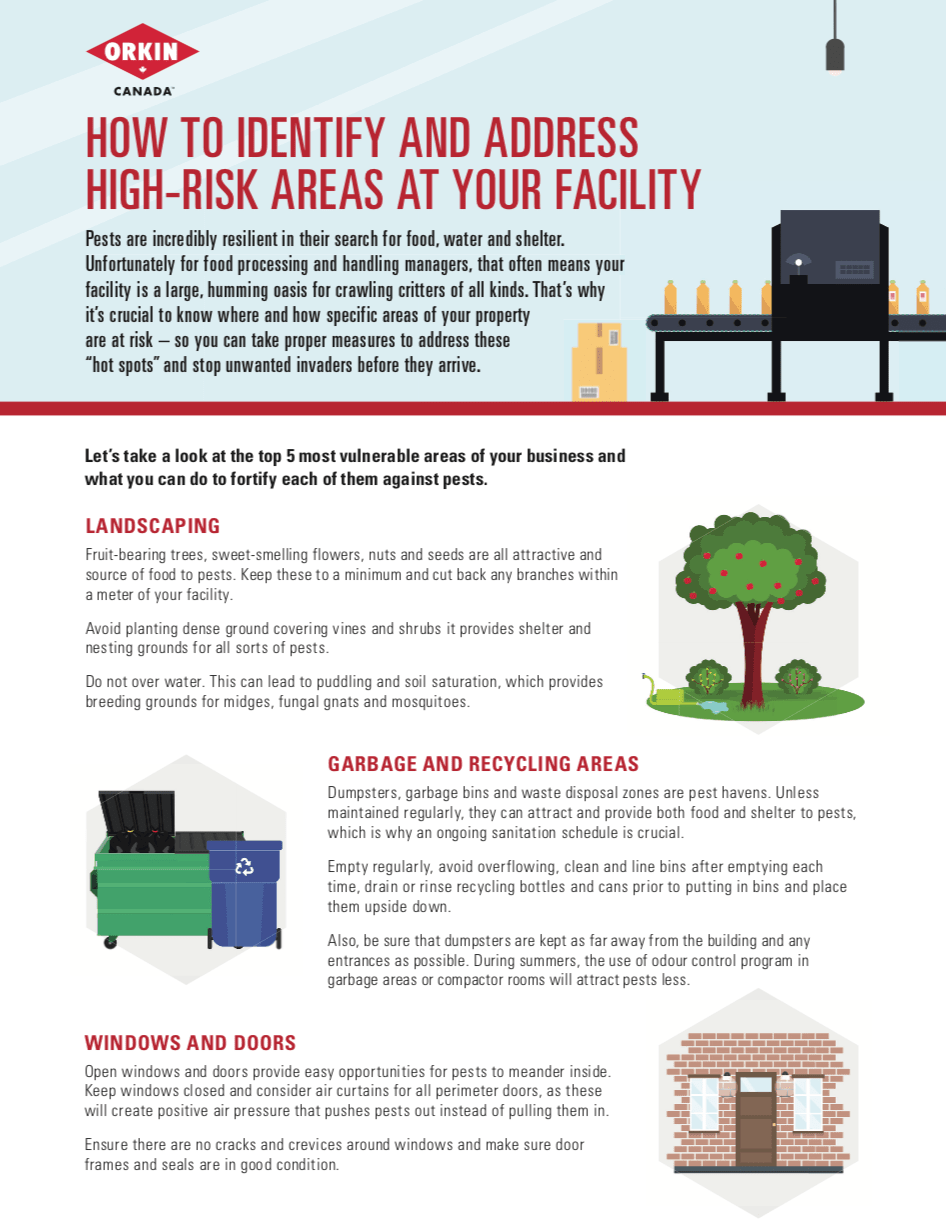Pests are incredibly resilient in their search for food, water and shelter. Unfortunately for food processing and handling managers, that often means your facility is a large, humming oasis for crawling critters of all kinds. That’s why it’s crucial to know where and how specific areas of your property are at risk – so you can take proper measures to address these “hot spots” and stop unwanted invaders before they arrive. Let’s take a look at the top 5 most vulnerable areas of your business and what you can do to fortify each of them against pests.
Landscaping
Fruit-bearing trees, sweet-smelling flowers, nuts and seeds are all attractive and source of food to pests. Keep these to a minimum and cut back any branches within a meter of your facility.
Avoid planting dense ground covering vines and shrubs it provides shelter and nesting grounds for all sorts of pests.
Do not over water. This can lead to puddling and soil saturation, which provides breeding grounds for midges, fungal gnats and mosquitoes.
Garbage and Recycling Areas
Dumpsters, garbage bins and waste disposal zones are pest havens. Unless maintained regularly, they can attract and provide both food and shelter to pests, which is why an ongoing sanitation schedule is crucial.
Empty regularly, avoid overflowing, clean and line bins after emptying each time, drain or rinse recycling bottles and cans prior to putting in bins and place them upside down.
Also, be sure that dumpsters are kept as far away from the building and any entrances as possible. During summers, the use of odour control program in garbage areas or compactor rooms will attract pests less.
Windows and Doors
Open windows and doors provide easy opportunities for pests to meander inside. Keep windows closed and consider air curtains for all perimeter doors, as these will create positive air pressure that pushes pests out instead of pulling them in.
Ensure there are no cracks and crevices around windows and make sure door frames and seals are in good condition.
Roof
Birds, carpenter ants, rodents and even raccoons are crafty and can find their way into your building from the top. That is why it is important to trim back any hanging tree branches.
Buildings with flat rooftops hold water and can provide breeding spots for midges and mosquitoes that can make their way through ventilation system indoors.
Facilities that process sweet aroma products such as candies are attractive to wasps where they enter via rooftop vents. Ensure your rooftop vents are insect proofed.
Storage Areas
Since they don’t undergo regular cleanings, storage areas and hard to reach spots are particularly susceptible to pest invasion. Inspect packages at the loading dock instead of moving them directly to storage, and place supplies on open-backed shelves to remove pest hiding spots.
Also, schedule regular cleanings of these areas, clean spills promptly and eliminate clutter to deter pests.
What else to look for
While the five areas listed above are some of the most common at-risk places for pests, you should be actively monitoring other parts of your facility as well, including parking lots, draining areas, lighting fixtures, walls and equipment.
You’ll also want to limit the attractants around your facility to help keep pests from showing up in the first place. This can be especially challenging in a food processing environment but is necessary for the safety of your employees, customers and products. Limit the exposure of any raw ingredients (including cereal, seeds, nuts, dried fruits and preserved meats), clean up spills quickly, eliminate excess moisture and watch for pests seeking shelter in overhanging structures.
Beyond all of the tips listed above, it’s wise to consult with a pest management professional that practices Integrated Pest Management (IPM), a holistic approach that helps prevent pest activity while reducing the need for chemical treatments. Following sound advice and working with a trusted professional is the best strategy for keeping your food processing facility safe and profitable year-round.
Want to learn more about how to protect your food processing facility from pests? Read a detailed tip sheet from Orkin Canada here.
You may also like
Canada's Top 25 Bed Bug Cities Of 2023
Bed bugs are extremely efficient hitch hikers. They can move easily across a room and climb onto luggage or anything left on a bed in just one night. Learn which cities have made Canada’s top 25 bed buggiest cities.
British Columbia's Top 20 'Rattiest' Cities 2023
As winter approaches, pest control leader Orkin Canada reminds homeowners and business owners to take precautions to help keep rodents out. Cities are ranked by the number of rodent (rat & mice) treatments the company performed from August 1, 2021 through July 31, 2022.
Ontario's Top 25 "Rattiest" Cities 2023
Pest control leader Orkin Canada reminds home owners and business owners to take precautions to help keep rodents out. Cities are ranked by the number of rodent (rat & mice) treatments the company performed from August 1, 2022 through July 31, 2023. This ranking includes both residential and commercial treatments.
Eastern Canada's Top 15 'Rattiest' Cities 2023
As winter approaches, pest control leader Orkin Canada reminds homeowners and business owners to take precautions to help keep rodents out. Cities are ranked by the number of rodent (rat & mice) treatments the company performed from August 1, 2021 through July 31, 2022.
Remove pests from your home, and stop them from coming back
We work hard to listen, understand and assess your unique situation. Request a free, no-obligation estimate today for a customized pest program that fits your needs.
Request a Free Home EstimateRequest a Free Business Consultation


